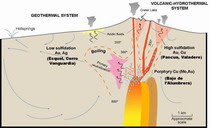Surface Geology
The Patuha Geothermal field is located in West Java approximately 45 kilometers southwest of the city of Bandung. The nearest sizable town to the project area is Ciwidey, located about 15 kilometer to the north.
The Patuha Geothermal field is located in West Java approximately 45 kilometers southwest of the city of Bandung. The nearest sizable town to the project area is Ciwidey, located about 15 kilometer to the north.
 The field occurs within a Quaternary volcanic highland with several volcanic centers including Gunung Urug (+2201 masl), Gunung Patuha (+2414 masl) and Patuha Selatan (+2390 masl). The surface rocks in the project area is primarily covered andesitic lavas and pyroclastic rocks, the dacitic lavas dome is distinctly observed at Gunung Urug and Patuha Selatan. Most of drillsites are located at the elevation of 1800-2200 masl. An eastward extension of the same mountain range includes the Wayang Windu geothermal field, located around 30 kilometer to the east. The land in Patuha area is used primarily for growing tea and protected forest.
The field occurs within a Quaternary volcanic highland with several volcanic centers including Gunung Urug (+2201 masl), Gunung Patuha (+2414 masl) and Patuha Selatan (+2390 masl). The surface rocks in the project area is primarily covered andesitic lavas and pyroclastic rocks, the dacitic lavas dome is distinctly observed at Gunung Urug and Patuha Selatan. Most of drillsites are located at the elevation of 1800-2200 masl. An eastward extension of the same mountain range includes the Wayang Windu geothermal field, located around 30 kilometer to the east. The land in Patuha area is used primarily for growing tea and protected forest.Surface Hydrothermal Activity
The surface thermal features are widespread at the field, including active fumaroles, mud pools, steaming ground and hot springs. Thermal features are all located within 2 kilometers of the margin of the youngest volcanic activity. Major high-elevation fumaroles areas occur at Kawah Ciwidey, east of Gunung Urug; Kawah Putih at south of Gunung Patuha; and Kawah Cibuni located 3 kilometers west of Gunung Patuha Selatan.
 There is a clear magmatic contribution to the steam discharged at Kawah Putih, based on the extremely low pH (1) and high chloride levels (17000 ppm) in the lake water at the Kawah, which is located at elevation of 2240 masl. The hot springs groups occurs in the northern part of Kawah Putih at Cimanggu, Rancawalini, and Barutunggul. These springs discharge dilute, neutral pH Na-HCO3-SO4-Cl waters. Others warm springs discharge at Cisaat, southwest of Kawah Cibuni, and at Cibunggaok, southwest of Gunung Urung. A cold gas seep appears at Kawah Tiis, about 3 kilometers southwest of Gunung Urug. Two cold, mineralized springs discharging dilute, acid-chloride-sulfate water emerge about 1.5 kilometer east of Kawah Putih. The presence of active thermal features and very young volcanism made the field one of the attractive target for commercial development.
There is a clear magmatic contribution to the steam discharged at Kawah Putih, based on the extremely low pH (1) and high chloride levels (17000 ppm) in the lake water at the Kawah, which is located at elevation of 2240 masl. The hot springs groups occurs in the northern part of Kawah Putih at Cimanggu, Rancawalini, and Barutunggul. These springs discharge dilute, neutral pH Na-HCO3-SO4-Cl waters. Others warm springs discharge at Cisaat, southwest of Kawah Cibuni, and at Cibunggaok, southwest of Gunung Urung. A cold gas seep appears at Kawah Tiis, about 3 kilometers southwest of Gunung Urug. Two cold, mineralized springs discharging dilute, acid-chloride-sulfate water emerge about 1.5 kilometer east of Kawah Putih. The presence of active thermal features and very young volcanism made the field one of the attractive target for commercial development.Subsurface Geology
The wells drilled in the Patuha Geothermal Field have encountered two major lithological groups, the shallow interbeds of tuffs-lithic tuffs, breccias and andesitic lavas at the thick of 0-920 meters and the deeper andesite complex intrusive volcanic rocks mainly microdiorites.
In The Ciwidey sector, the shallow group about 600-900 meters thick is made up of interbeds of volcanic lavas (andesites, dacitic-ryolitic andesites) and pyroclastics (tuffs, tuff breccias, lithic tuff, andesite breccias). The deeper unit is described as intrusive andesite complex and generally called microdiorite dikes and is the reservoir rocks in Patuha Toward Kawah Putih from PPL-02 to PPL-04 the cumulative drilled portions of the pyroclastic material is thicker than the lavas flows.
The alteration minerals present are similar to those observed in the most other benign geothermal reservoirs. Argillic alteration forms a generally impermeable cap over the reservoir. Propylitic minerals including chlorite, calcite, epidote, sericite, and actinolite characterize the fractured geothermal reservoir.








